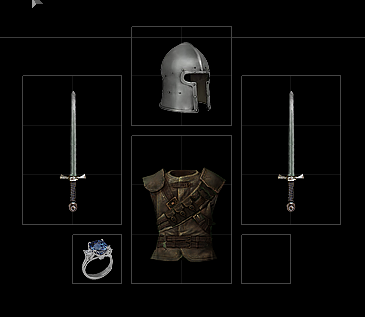Since you are doing your own game "in the style of" with the gear looking only to be tailored to combat, think about exactly what damage and effects on combat that they will do.
What is the primary function of this equipment for each gear slot you might use?
What are the stats or modifiers that will show up at a high frequency (75%+) for each gear slot?
Will there only be bonuses or will there be penalties too (will a 2h weapon get a damage bonus but slow your attacks)?
Will you divide up physical damage to Pierce (spears), Slash (swords), and Crush (mace/club)?
Will there be elemental magic/bonus damage (fire/water/etc)?
Will you make specific tiers of gear (iron sword/steel sword/etc)?
Will you have items with specific bonuses, random unique gear with bonuses not normally found on that gear, random artifact gear, fixed/static artifact gear, or even gear that is necessary to drive the plot (defeat the critter while using the sponge of purity)?
Will there be any type of crafting, adding runes or gems to gear for extra bonuses?
By doing the above you will be able to feel out if you have too few or too many gear slots. You will see what the function of each is, what the expected stats and modifiers are, and if that gear would be worth being in your game.
Then you need to check the start to end values for the gear, keeping in mind the players party need their gear to be slightly ahead of the curve. Losing a few battles or having tough battles isn't a problem, but too weak of a party for a type of encounter too many times will frustrate players. Of course carving up all the critters in an instant would be pretty boring too.
In the beginning the party needs to be able to defeat early encounters easily to build up for later, but you need to consider what gear and stats/modifiers will be needed when you encounter TUTATEOTD (The ugly thing at the end of the dungeon) aka the final boss. As an example, if helmets reduce the chance of an incoming critical hit or reduce the amount of damage from a critical hit, it might not be too important at the start, but might be really necessary to survive late game or final battle.
If the players like the game and balance and the equipment handling is easy and effective the total number of slots doesn't really matter, only that each slot serves a function to better that character's power along the way so the player believes they have a chance at winning the the next battle.
If you can get all 6 characters gear sets on the same screen, and have the inventory and gear sort selections below, using drag and drop for all the items you were thinking of (helmet and armor included) would be quite easy. Just make sure you can drag and drop from one character to another.
Sorting problems are normally created by too much junk and limited sorting options. You might want to think of a gear rating for all gear types. If you do this and allow the selection of one character, the sort could show the items that have a better gear rating than currently equipped gear for the highlighted character to reduce the pile sorting time. If you are sorting by "strength" it could show the items that have more "strength" as highlighted (and maybe sort them to the top).








